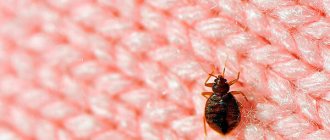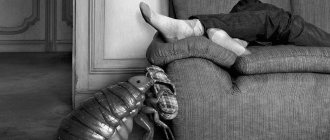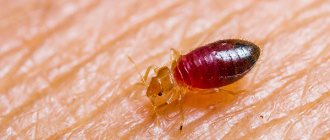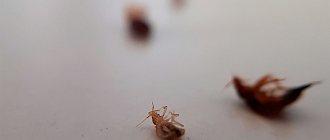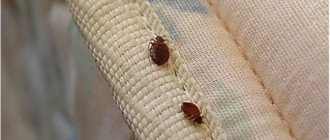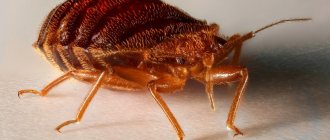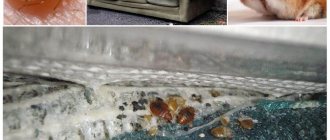How long can bedbugs live without food?
You should not plan to move from an infested apartment, hoping to starve the parasites to death.
Bedbugs are capable of moving quite quickly over considerable distances, and if the food source disappears from the available resources, the insects migrate in search of other food. In apartment buildings, nothing prevents bedbugs from moving into neighboring living areas through ventilation holes or cracks in the walls. In private homes, parasites will survive until humans appear, feeding on the blood of pigeons or chickens. Bedbugs will not die if you completely deprive them of food. They can live without blood for quite a long time - from several months to a year and a half. In addition, it became known that a bedbug is able to obtain a portion of food from another insect in whose body it is present. Thanks to this ability, the population will gradually decrease, but will remain for a long time.
Furniture bugs
Insects found not in the bed, but in other furniture, are representatives of the species bed bugs. With a multiple increase in the number of parasites, they begin to spread throughout the room and move into neighboring rooms. They hide in the drawers of bedside tables and chests of drawers, on the shelves of closets, behind paintings and mirrors.
Bedbugs are found in furniture only during the day; when night falls, they move to the nearest place where a person sleeps.
How to get rid of furniture bugs?
There are many methods for exterminating pests:
- thermal;
- chemical;
- folk recipes.
Treating furniture at home with chemicals is considered the most effective method. The “Get” insecticide, produced in the form of a suspension, has proven itself well. It is diluted with water and sprayed on all surfaces. The product retains its effect on parasites for several months. Aerosols “Combat” and “Clean House” are popular. They paralyze insects and quickly cause death. The downside of the drugs is toxicity and a pungent odor.
As a heat treatment, furniture is subjected to freezing or exposure to steam. Folk recipes recommend the use of essential oils (lavender, tea tree) and herbs (wormwood, tansy). It is often suggested to treat furniture with vinegar or other products with a strong odor. Such recipes only have a deterrent effect. If you can’t deal with parasites on your own, call a professional.
Where do bedbugs live?
House bugs do not ask your permission, they always come uninvited and can settle anywhere. They can be found in a village house, in a hostel, in a hotel, in a good city apartment. There are no barriers or boundaries for these insects; apartment bugs are found all over the globe - in Moscow, Paris, Astana, New York; bedbugs are found even in hot African cities and in villages located beyond the Arctic Circle. Wherever people live, we can find bed bugs.
As you might guess, these parasites are called “bed bugs” for a reason - bedbugs live primarily where a person sleeps, that is, in bed. It doesn't matter where you sleep - in a bed, on a pull-out couch, or on a mattress on the floor, bedbugs will find a place to settle. Being secretive insects, they always choose secluded places for their nests, and thanks to their flat physique, almost anything can serve as a secluded place for a bug. Furniture bugs can settle in the folds of sofa upholstery or bed linen, in the joints of furniture - wherever there are small cracks, holes or mattress folds. You can see photos or videos on the Internet to see what bedbug nests look like.
If the apartment is infested with bedbugs, then most likely most of them live in the immediate vicinity of your bed at night, but they can be found in any corner. The bedbug happily establishes colonies in soft toys, behind wallpaper that has come off the wall, in apartment baseboards, even in sockets. Individual travelers can get into any corner of the living space, including household appliances and clothes, even if they are hanging in the closet on a hanger. It’s not for nothing that these insects are sometimes called body bugs, so you shouldn’t be surprised when you see them on your body.
Bedbug food
These insects lead a parasitic lifestyle and feed exclusively on blood. At night, they bite through the skin of humans (sometimes animals) and suck blood from the wound. One meal of parasites is approximately 7 ml of blood. The bug gets this volume in just a few bites.
To prevent the victim from waking up, the pests have developed a deceptive mechanism: they secrete saliva into the wound, which contains an anesthetic substance. The bite of a vampire insect and the pumping of blood are practically not accompanied by any sensations, and the person attacked continues to sleep.
Having received their 7 ml, the bugs go back to their shelters. There they remain until the next meal, that is, 6–10 days. All this time is spent on digestion in insects.
Bedbugs live a little over a year. Insects of both sexes and all stages of development drink blood - females, males, larvae that have recently emerged from eggs. By the way, if a larva bites, it can be noticeable: it has not yet formed an anesthetic substance in its saliva.
Bedbugs go hunting at night, from 2.00 to 7.00. A hungry individual becomes satiated in 4–7 minutes, making approximately one bite per minute.
A well-fed bug swells to almost 1 cm, becomes rounded and darkens. Having eaten, the parasite immediately goes to shelter.
A hungry bug differs from one that has eaten by half the size (about 5 mm) and color. A bloodsucker going out to hunt is white, almost transparent, then as it becomes saturated with blood it turns yellow, then becomes brown and, finally, bright red.
Bedbugs, like all parasites, stay close to their food source, in other words, they exist next to humans in their homes. Pests “come” to houses and apartments on old things and pieces of furniture or directly on a person.
In apartment buildings, parasites move freely between apartments and floors. The insect moves at a speed of approximately 1 meter per minute.
Why do bedbugs travel? They are driven away by hunger or persecution with pest control agents.
During the day, insects hide close to the food source - they look for shelter near a person’s sleeping place. Bedbugs do not build nests, but simply hide in secluded corners and folds of upholstered furniture - sofas, armchairs. Insects find excellent warm shelters inside computer system units, as well as in books, behind paintings, posters, and in boxes. If there are a lot of parasites, they settle in the spaces under the baseboards, under the wallpaper, etc. A typical smell appears: it is produced by the odorous glands of insects.
Any home (regardless of the level of hygiene) can be infested with bedbugs. There are especially many of them in hostels, hostels, and hotels.
The main ways bedbugs can get into your home in Moscow
Bedbugs move between apartments in a residential building in Moscow through cracks, ventilation grilles, and so on. This small insect (3-5 mm) can crawl through even the smallest and most inconspicuous hole. Often “new neighbors” appear in an apartment as a bonus from a not-so-clean construction team. These insects often live in new furniture in storage, and owners of new furniture receive them as part of their purchase. Bedbugs can even be brought into your home with new, store-bought clothes that they may have moved onto.
Insects can get onto your clothes from a chair or armchair you were sitting in, a hotel bed, a shelf or bedding on a train. Therefore, from a trip, a visit or to some institution, it is quite possible to bring bedbugs, which, due to their small size, are completely invisible in the folds of the fabric.
Feeding of bedbugs depending on the type of parasite
There are about ten thousand species of bedbugs in nature, and the difference between them will also be in their diet. Therefore, it is worth considering the main species that can be found in nature and what bedbugs feed on besides blood:
- water bugs. Few people know, but the well-known water striders are also bedbugs. These animals are true predators and feed on the eggs of small fish, mosquitoes and other insects. Water bugs also include the smoothie, which is the largest representative of the bugs (1.5 cm). Such sizes allow the parasite to feed not only on invertebrates, but also on small fish and various insects;
- land bugs. Vegetarians predominate among land bugs. But even such a diet often brings losses to agriculture. A striking representative of land bugs is the turtle bug. This parasite received this name due to the fact that the outer shell resembles that of a turtle. The parasites try exquisite varieties of plants and cereals. They pierce the stem of the plant and introduce their enzymes inside, thereby completely changing the composition of the plant. Subsequently, infected plants are of very low quality and practically not suitable for consumption;
- shield family. This family has about 4,000 species of parasites that primarily feed on plants. A characteristic feature of these bedbugs is the shape of their back, which resembles a shield. Prominent representatives of this species are: green wood bug (feeds on berries and young shoots of grass), cruciferous bugs (attempts to eat plants of the cruciferous family (cabbage, rapeseed)), Italian bug (prefers to eat dill).
Who eats bedbugs
People who have encountered parasites often wonder whether there are insects in nature that feed on bedbugs. In fact, such insects exist, and they are seven-spotted ladybugs, which are predators. There are quite a lot of such insects in Russia and they mainly try small arthropods that move quite slowly and live in colonies. Bed bugs also belong to this type. The diet of ladybugs consists not only of bedbugs, but also their larvae, so these insects bring double benefits to humanity.
As a result, we can say that bedbugs do not have a single diet. The most dangerous bed bug for humans, since its main diet is human blood
Rats and mice
What if a rat or mouse eats poison - will it die somewhere in the house and then there will be an unpleasant smell?
This should not happen, since in our work we use only drugs with a mummifying effect - this is when only a shell remains of the pests, or drugs that contain a special substance that increases their pressure and lack of oxygen, which makes rodents want to run out of the room into the air and are already dying on the street.
We have pets in our house. What happens if a pet eats poison for rats or mice and gets poisoned too?
Do not worry! All baits are placed in places that are as inaccessible to pets as possible. In addition, the certified preparations used include a special substance that tastes unbearably bitter (rodents do not have taste buds), so pets will not be able to swallow it. The poison in the preparations is also calculated based on the mass of pests, and domestic pets, for example, dogs and cats, are much larger than rats and mice, which means that for poisoning they need a significantly larger dose of the drug, which excludes the first sentences of the answer to the question.
Heavy artillery
When pests get indoors, homeowners are often tempted to try to solve the problem themselves. However, the truth is that most pests—from bedbugs and termites to wasps and other biting insects—are best left to exterminators. Professionals have the knowledge and tools to safely and correctly eliminate pest infestations.
If you are concerned about an infestation on your property, it is best to hire licensed local pest control professionals to assist in properly identifying and treating your home bed bug problem.
Methods of destruction
To treat habitats, you can use sprays from specialized stores, but keep in mind that these products will only help with direct contact with parasites.
The most effective chemicals are:
- Delta Zone is a microcapsule composition from Korea that provides protection for up to 4 months and is odorless.
- Get is a suspension with microcapsules that creates a barrier for six months,
- Xulat Micro is a Spanish composition with three active ingredients, odorless,
- Cucaracha is a budget composition to completely destroy bedbugs, but it has an odor and may require re-treatment,
- Tsifoks is a concentrate for self-treatment of an apartment; it has a slight smell of kerosene.
Can bed bugs pass from neighbors?
When deciding where these pests come from, you need to know that one of the main reasons for their appearance is migration. Moreover, in an apartment there are more opportunities for the movement of parasites than in the private sector.
To leave their homes and move to the house of a new owner, bedbugs must find more attractive living conditions:
- If a person is not in the old place for a long time, for example, he left in the hope of getting rid of bedbugs in this way, the parasites will soon populate another apartment.
- When living conditions at home change, for example, the air temperature drops significantly, insects may choose new housing.
- Other reasons for migration: chemical treatment of the territory, the use of folk remedies that allow you to fight parasites on your own.
If there are no other obvious causes of infection, then the bedbugs come from the ventilation shafts, move along the outer wall of the apartment building and penetrate the windows, for which it is enough to open the sash or leave a small crack in the frame or between the profile and the wall unfilled.
Methods for exterminating bedbugs in Moscow
Destruction of bedbugs on your own
Probably many have encountered the presence of bedbugs in residential premises. This is not only unpleasant, but can also be harmful to health. This article will discuss several ways to independently exterminate harmful parasites.
Use of aerosols
At the moment, the most practical and less expensive way to kill insects is the use of toxic aerosols. A special spray can be purchased in a store or ordered online. Typically, such products are sprayed onto the surface affected by bedbugs. Thanks to their properties, aerosols kill bedbugs as quickly as possible. An important component when using toxic drugs is compliance with safety precautions. When spraying poison into places where insects accumulate, most of the harmful substances enter the air and can cause harm to both humans and domestic animals. Therefore, after using aerosols, it is recommended to leave the room.
Insecticidal powders
Very often, store sellers offer to poison bedbugs with specialized means, in the form of powder or crayons. Such drugs often do not bring the desired result. It must be remembered that bedbugs do not feed on anything other than blood, so you should not hope that the insects will consume poison as food. It follows from this that when choosing powder insecticides, you should carefully read the composition of the substance. In addition to intestinal poison, there must also be a contact poison. Thanks to such powders you can get rid of pests, but it will take a lot of time.
Temperature treatment
All insects have a temperature limit, beyond which they die. House bugs are no exception. Scientists have long found out that bedbugs cannot withstand temperatures of minus twenty-two degrees Celsius. In regions where the climatic conditions are quite cold, people take bedbug-infested furniture outside. Many even leave their apartments for several days to fully ventilate the premises. Insects can also be controlled using high temperatures. Insect nests are doused with boiling water or a stream of steam. Such actions are advisable only if bedbug nests are accurately identified. Most often, this method is used by professional bedbug fighters who have special steam generators and other steam supply tools.
Folk remedies
Nowadays, people have come up with a huge number of remedies that should help get rid of bedbugs. Not all of them can be called truly effective. The most popular folk remedies are ammonia and vinegar. These liquids can be applied to bedbug nests and wait for a positive result. But you should still understand that these remedies will only help with a small number of insects. It is worth summing up all of the above. Fighting bedbugs is a very difficult and responsible process. You can completely get rid of these insects quite quickly, but there is no guarantee that they will not appear again. Most often, these parasites get into apartments from neighbors, so when fighting bedbugs, you need to act together. It is best to try to find a common language with the residents of the house and carry out a complete cleanup of harmful insects.
How to find bedbugs and get rid of them?
It is necessary to look for a nest of bedbugs the first time they are discovered, before they multiply to incredible numbers. Having examined all the habitats listed above, it is recommended to check all inaccessible points of the home such as:
- ceiling plinths and baguettes;
- sconces and lamps;
- stacks of waste paper;
- mezzanines with things that are not used in everyday life;
- under carpets and linoleum.
Having identified all habitats and determined what bedbugs do during the day and how they exist at night, you should immediately begin extermination. From the existing drugs, you can choose both expensive and budget ones, but less effective. What is the best way to get rid of bedbugs in an apartment?
- If you live in a metropolis, for example in Moscow, call professional exterminators from a specialized organization, they will effectively and quickly destroy bedbugs. The cost of such a service averages from 1,500 to 2,500 rubles.
- You can buy insecticides widely available in specialized stores and supermarkets. When used correctly, they give good, excellent results, but re-application is necessary after two weeks. The cost of preparations for self-disinfestation is about 500 rubles.
- Try traditional methods of removing bedbugs, they are completely safe for the health of others. But practice has proven that such methods are effective with a tiny number of insects and they are much inferior to modern chemistry.
- If the parasites have not taken root and only one small cluster is found, you can destroy them with hot steam or boiling water, washing the laundry at high temperatures and steaming the mattress with a household steamer.
- Bedbugs cannot tolerate low temperatures, so you can take infected items out into the cold - onto a balcony or outside - and leave them for two days.
Useful article, thank you! I don’t like it, delete it!
Myth 11: Bedbugs only live in dirty apartments
It is difficult to even list all the consequences that this misconception leads to. At best, people for a long time, until the very end, refuse to admit to themselves that it is bedbugs that have settled in their house. They look for mosquitoes, boil their things to get rid of lice (although in people who observe sanitary standards, lice appear much less often than bedbugs), they even treat themselves for allergies, but cannot believe that they have bedbugs, because they believe that their the apartment is too clean for bedbugs. In the worst case, a person is embarrassed to call disinfectants, believing that he will be exposed to ridicule. Like, he brought the apartment to such a state that there were bedbugs.
The most dangerous consequence of such a myth is untimely baiting of bedbugs. Ideally, disinfection should be called immediately after parasites are detected, and they should be searched for and detected immediately after the first bites appear. With this approach, it is easiest to destroy insects (since there are few of them in the apartment), and it is inexpensive.
When a person refuses to admit to himself for weeks or even months that there are bedbugs living in his apartment, during these weeks or months the parasites confidently multiply, settling in all hard-to-reach or even inaccessible places in the apartment. And when the situation becomes completely clear, it is much more difficult to poison these multiplied insects than when the infestation of the premises has just begun.
Here, for example, is a sofa from which the owner spent several months trying to get bedbugs out on her own:
In reality, bedbugs are completely indifferent to which apartment they move into. It is important for them that people live here and that the temperature is maintained above +20°C. All. Whether there will be a pigsty with a stash here, or there will be an ideal expensive renovation - they don’t care. We poisoned bedbugs in apartments in which people wore street shoes and, excuse the details, defecated under the walls in the rooms. And in the same way, we poisoned bedbugs in apartments in Moscow City, where one sofa cost more than a new car. In both places, bedbugs feel great.
Therefore, if you have suspicions of bedbugs, regardless of how well-kept your apartment is, make every effort to either accurately confirm these suspicions or accurately refute them. Simply put, if something bites you, first of all find out what kind of parasites it is, without rejecting any of the possible versions. Including check all the places where bedbugs may be hiding, and make sure that they are bedbugs or other insects. And then take adequate measures to destroy these parasites.
Bedbug - who is it and why is it dangerous?
The bedbug is most often found in our region and, accordingly, it is this type that raises the most questions. Bed bug - who is it and why is it dangerous? This is a type of bug that lives and lies in wait for people in their place of rest - in bed, which is why it gets its name. They are very small in size and have a dark brown body color. The body of the bug is too thin and flexible, so it is almost impossible to crush it. The bug moves using a person's belongings - this is its only opportunity to survive, to get to a residential place where it will have something to eat. In search of food for itself, a bug can independently climb from floor to floor without human help. Thanks to his body, he can get to almost any place in the building without much effort, which makes it difficult to capture and destroy him.
The activity time of house or bed bugs is from two to seven in the morning. During this time, they leave their shelters, find a person using the acuity of their sense of smell (the smell is captured by the carbon dioxide that a person emits during breathing) and drink the required amount of blood, after which they immediately hide in their home in an inconspicuous place.
Bed bugs prefer moderately warm conditions, so from April to September they reproduce faster and begin to attack more aggressively. Since this is the time of travel, you can bring bedbugs to your home from vacation, cottage or even the office where you work. At this time, you need to at least use preventive methods against the appearance of bedbugs in your home, and if you notice their presence, immediately begin to fight them.
How can bed bugs be dangerous? Naturally, the main danger is bedbug bites. The places where they bite begin to itch very much, and sometimes this can cause a second wave of an allergic reaction. With certain characteristics of the human body, bedbug bites can even cause fever, headache and nausea.
Due to severe itching, a person may begin to scratch the bite until a wound appears. And through this wound, various dangerous bacteria from the external environment can enter the body, which can negatively affect health. Due to regular bug bites, a person can develop a sleep disorder, because constant itching in various parts of the body greatly interferes with healthy sleep.
How to get rid of bedbugs
If the above factors are present in the apartment, it is necessary to urgently deal with the destruction of bedbugs. It is not possible to get rid of them using folk remedies. It is necessary to fight them with special strong drugs. You need to immediately go to the stores in Moscow or the city where you live and purchase strong anti-bedbug remedies and begin treating the apartment. You can first read the reviews of people who were able to get rid of bedbugs forever. It is unacceptable to live in the apartment in which they live. After their bites, wounds remain, an allergic reaction appears, and an infection can be introduced into the body.
When processing a room, special attention should be paid to wardrobes, where they like to hang out. Sometimes individual individuals can choose clothing for their habitat; larvae can settle in it
If even a small number of bedbugs remain after treatment, after a short period of time they will breed again.
Myth 2: Bedbugs somehow selectively bite people
It is due to the fact that in the same room, traces of bedbug bites are found on some people, but not on others. Accordingly, people decide that bedbugs bite some people and leave others alone. And then they build whole theories about how bedbugs choose a victim: by blood type, by smell or by other characteristics.
We have devoted a separate article to this misconception. You can watch it.
In short, bedbugs bite all people equally intensely, it’s just that in some people their bites cause pronounced reactions with noticeable consequences in the form of bumps and itching, while other people are insensitive to their bites, and such bumps and itching do not remain on their body. Accordingly, in the morning after equally strong bites from all the people in the apartment, some have bite marks on their bodies, while others do not. This is all the more relevant when you consider that more than half of people either do not feel bedbug bites at all, or the consequences of these bites go away before the person wakes up.
There are suggestions that bedbugs are somehow a little more attracted to certain people, but this difference in attractiveness is practically not reflected in the intensity of bites. That is, in an infected room, all people will be bitten, just one person will be bitten by 20 bedbugs per night, and another by 18. With the same sensitivity, you will not notice the difference between the number of bites, but with different sensitivities, the differences in the consequences of bites are obvious.
This myth leads people to believe that bedbugs live in the same sofa, or in the same room where people sleep and constantly develop bite marks. But in a sofa or in a room where a person who does not suffer from bedbugs sleeps, these parasites are not present. Accordingly, they poison bedbugs only in one sofa or in one room; insects in other places remain unharmed and cannot be removed.
The protection against this misconception is the same as in the previous case: a complete inspection of the apartment and all the places where bedbugs can hide. After such an examination, it will become clear where they need to be poisoned in order to destroy everyone.
We look for bedbugs and find out if they are
Using a flashlight and a hard, flat-edged object, such as a credit card or paint scraper, inspect beds, mattresses and other areas where you suspect bed bugs. Look for bed bugs, eggs, feces or shed skins as evidence of an infestation. Be sure to look into cracks, crevices, and folds of fabric and furniture. You may also want to wear protective gloves during this inspection.
- Bed bugs are attracted to heat. The number one hiding place for bed bugs is in mattresses and beds. Inspect your sheets for blood stains that may have been left by bedbugs. Be sure to carefully inspect the seams and folds of the mattress in addition to any corners or crevices of your bed.
- Bed bugs also like to linger in areas where people sit or remain inactive for long periods of time. Sofas, armchairs, and even office chairs are popular hiding places for bed bugs. Be sure to look under furniture where the fabric meets furniture legs and between seat cushions.
- Bed bugs will also hide around the perimeter of the room. The edges of baseboards and carpets should also be checked.
And you must be prepared: if there are bedbugs, it will be difficult to get them out. You can get rid of them forever only when the premises are treated by specialists, and they will have to be poisoned several times.
Bedbugs are able to survive in the most difficult conditions!
People often call our company and wonder if they can kill pests themselves if there is only one bug or bite and, in their opinion, there is no point in calling a professional exterminator. They ask you to recommend effective preparations to spray sleeping areas. We never refuse help.
But we are trying to explain that where one bug bites, most likely there are traces of its fellows. It’s easy to check: an adult bug usually feeds once every 5-10 days and sucks up to 7 mg of blood. If bites appear more often, then he is not acting alone. And in general, bedbugs do not live alone in an apartment; if a bug appears, it means there is a nest nearby.
A nest of bedbugs behind loose wallpaper in an apartment
Then the remaining rooms of the apartment are inspected. The cabinets are moved away from the walls, a thorough inspection of the wallpaper behind them is carried out, if necessary, the baseboard is dismantled, and the floor covering is removed. Bookcases are inspected in detail (bugs can live in the spines of old books), panels and paintings are studied.
In our practice, there were cases when the location of bedbugs could not be detected in an apartment at all, but the parasites continued to bite people. And this happened because the nimble bloodsuckers, who lead a nocturnal lifestyle, made forays from their neighbors every night, and during the day they returned to their hiding places, where they were not visible. There can be only two solutions in this situation:
- The first is to agree with your neighbors to jointly remove parasites and carry out disinfestation of the premises at the same time;
- The second is to isolate the apartment as much as possible, that is, make sure that pests have no chance of getting into it.
The second option is not the best, but sometimes the only possible one, especially if the neighbors are intractable. There have been situations when bedbugs in an apartment were completely destroyed during pest control, but literally a few weeks later they were taken back from the neighbors again, and the whole epic was repeated all over again. There were even cases where people had to move out of their apartment because it turned out to be cheaper than doing a complete renovation of it.
In any case, it is often impossible to find absolutely all bedbug nests in an apartment, since some of them may be located in electrical wiring grooves in the walls, behind boxes, that is, in places where it is generally impossible to get to. In all such situations, high-quality processing compensates for such limitations in opening nests.
However, our practice shows that in order to remove bedbugs forever, you need to open the maximum number of their nests, and then treat the room as thoroughly as possible with both cold and hot fog. With this approach, we manage to completely remove bedbugs the first time in 83% of cases.
Myth 7: Bed bugs carry infections that are dangerous to humans.
This is a myth, since to date there has not been a single documented case in which it has been reliably established that the cause of infection was a bug bite or contact with any products of its vital activity.
We talked about this in detail in a separate article. The point here is simple: causative agents of infections dangerous to humans were actually found in the bodies of bedbugs. Among them are hepatitis C, leprosy, anthrax. Some of these pathogens have been found in bedbug excrement. But these pathogens are not directly transmitted to humans through a bite.
The only hypothetical chance of becoming infected is to scratch the bedbug bite until it bleeds and smear the feces that remain here on the skin over the wound. If viruses, bacteria, fungi or protozoa remain in these excrements, they can enter the wound and with it into the blood or tissues, where they begin to multiply.
This is interesting
It is in this way that the deadly Chagas disease is transmitted in Latin America, and, by the way, it is transmitted quite effectively - it infects thousands of people every year. But infection in the same way with diseases whose pathogens are found in the bodies of bed bugs is not known.
This myth does not in any way affect the effectiveness of bedbug control. But this misconception also affects the state of mind of people who discover bedbugs in their home and learn that anthrax and leprosy are found in the bodies of these insects.
In general, rest assured: the transmission of dangerous infections by bedbugs is a myth . You won't get infected with anything from them. But this does not mean that you can live peacefully with them.
Where do bedbugs like to live?
Bedbugs are very tenacious. It’s hard to imagine how many places they are ready to explore in a short time.
Below is a short list of the favorite places of residence of nocturnal bloodsuckers:
- Seams, folds of mattresses, box springs, sofas and all other furniture.
- Bedding, pillows, bed skirts, etc.
- Cracks in bed frames, chests of drawers or wood furniture, plaster or any other surfaces
- Curtains and other folds of fabric
- Cloth
- Behind wood molding (if there are cracks)
- Carpet edges
- Under the rugs
- Electrical sockets
- Knots in wooden furniture
- Screw heads
- Any items hanging on the wall, such as mirrors or picture frames
- Stuffed Toys
- Items stored under the bed
- Electrical appliances
Can bedbugs live in clothes?
Insects need secluded places to wait out the daytime period and lay eggs. Clothes that have been sitting in the bedroom closet for a long time become an excellent option for creating a nest. Darkness and stable climatic conditions are favorable factors for the life and reproduction of pests. As the number of colonies increases, parasites do not fit into the sleeping quarters, so they colonize the nearest territory. They are attracted to a closet or dressing room by the smell of a person.
Insects settle in seams and folds, often choosing outerwear - coats and jackets. Fur coats made from natural or faux fur remain clean. Bed bugs do not move well in dense hairs. Most often, dressing gowns, bedding, and dirty clothes that are not washed for a long time become infected.
How to get rid of bedbugs in clothes?
If parasites are found in the apartment, it is necessary to inspect not only the furniture, but also the clothing. The signs of parasites are the same - black spots, a specific smell. There may be white eggs in folds and seams. There are various methods for exterminating arthropods:
- freezing;
- steam treatment;
- wash at high temperature;
- use of chemicals.
Frost is ineffective in eliminating bed bugs. At low rates, insects fall into a state of suspended animation and survive. To kill them you will need a temperature of -17-20°. In case of slight frost, things are left for several days.
Parasites cannot tolerate high temperatures; they die at 50°. The best way to remove all insects from your clothes is to wash your clothes in hot water. For cotton fabrics, you can set a higher temperature of about 80-90°. The procedure is guaranteed to kill adult insects and their clutches. Steam treatment also gives excellent results. The procedure is carried out using a steam generator. The device produces steam at temperatures up to 100°, while its humidity is very low.
Infected items that are not exposed to high temperatures are dry-cleaned or treated with insecticides. It is worth finding out whether the products kill parasite eggs. If the clutch remains viable, a new generation of insects will appear.
Bed bugs are highly adaptable and resilient. They can survive without food and hide anywhere. These qualities explain the high percentage of infestations in residential premises. Parasites can and should be fought with all available means. In a difficult situation, it is worth calling professional exterminators.
Reasons why bedbugs may remain indoors after treatment
If the bedbugs do not disappear after treatment, but continue to bite at night, then there may be several reasons for this:
- Too little time passed, and the drug did not have time to act on all individuals.
- Poor preparation of the premises for disinfestation. For example, during treatment, some bedbugs remained under the dust and were not exposed to poison.
- Spraying was carried out with violations. Not all shelters have been processed.
- A low-quality product was used, or the solution was made too weak.
- Bedbugs have already been treated with a similar drug, and they have acquired immunity. In this case, the bedbugs do not disappear, but continue their normal lifestyle.
- Repeated disinfestation was not carried out and a new generation of bedbugs appeared.
- General cleaning was done before the recommended time had expired, which allowed some individuals to survive.
- After treatment, the bedbugs disappeared for some time, and then appeared again. Most likely, they returned from their neighbors, who also started destroying them. This happens quite often if preventative work has not been carried out in the apartment.
Preparing the premises
